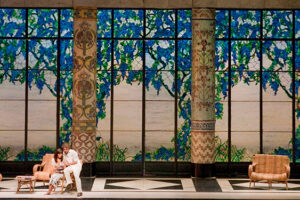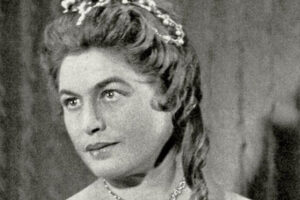

Monk’s name may not be well known to most opera aficionados, but she is famous as a vocal artist and vocal composer, and she devised a sublime grand opera, Atlas, twenty years ago. Atlas conquered the libretto problem that has dogged the form over the centuries; the story was clear, the roles subtly enacted, and the music consisted of the amiably minimalist melody of so much of her work. But the singing, as with so much of Monk, never bothered with words in any tongue at all: syllables would do.
Monk has always been able to inspire an extraordinary array of performers to do exactly what she wishes them to do, sing, move, play, enact. Her taste and command are exquisite. She has created her own audience, but it is not finite. I took a young friend who had never heard her to the premiere Wednesday night. He said he didn’t want it to end. (The program is about an hour and a half long.)
In some ways, On Behalf of Nature is a great surprise. The last time I attended a program by Monk and her ensemble, everyone was wearing black. (Onstage and off. New York was different.) This time, all the performers wore blue of different hues and textures and impressions, and about halfway through, everybody switched to white. (The costumes were by Yohio Yabara.) But then, the theme was Nature, and even when mourning, Nature is every color other than black.
Monk’s own ability as a dancer, singer, actress has always been extraordinary. I have seen her stroll around a stage leaning on another performer and spouting nonsense syllables and scat syllables in her shrill, calm, expressive, multi-referential vocal manner, evolving as she moved from small, nagging child to ungainly fool to lumbering gent to elderly lady in an almost artlessly natural sequence. You did not question it; you did not puzzle it through; you understood and accepted it.
Monk says she was inspired in the new piece by Gary Snyder’s essay, “Writers and the War Against Nature.” She is attempting to speak in behalf of that nature. She has attempted this in several ways: Imitating the sounds of nature (as birds taunting each other or bees buzzing across a field or another image that seemed to be trains passing in the night that struck me as bucolic, but no doubt I misunderstood it).
Or there was something under nature inaudibly perceptible to us, as a couple (a couple of what?) in languid, perhaps romantic conversation of which we hear nothing but the harmonized hum between them that murmurs underneath talk in their cozy relation to each other.
In one duet, while the other performers plodded aimlessly, one dancer, apparently reacting to jittery percussive waves, lurched constantly into lively dancing patterns seemingly misunderstood or ignored by everyone around her.
People greet and part and disperse and wend their ways, dancing, dreading, fleeing. Crowds dissemble and reassemble and enact rituals and relations that dissolve as abruptly and inexplicably as they cohere. We might be looking at a subway platform or a bunch of commuters on a summery day, rushing or lingering or crowding, as much as we might be seeing flocks of birds or beasts coalesce and disperse against the sky.
t one point all six of the “performers” (but the three instrumentalists too “perform”) abruptly moved downstage in a semicircle, focused intently, pitilessly, as if on a cockfight they all had bets on—but there are no cocks embattled. Shared intentness brings focus.
The instruments are largely percussive, marimbas and xylophones and light drums, but violins and harps and bass clarinets and French horns have their moments, and sometimes their sound seems to emerge from the throats of the performers, and sometimes it is electronic. It is all very free except it is all very tight. (The sound design is by Jody Elff.)
A set of glass discs descends on wires, and one by one the performers toss them about till all the discs are swinging, each in its own direction, catching the light and the music. (The lighting is by Elaine Buckholtz.) Then each one stands by a disc and pulls it, and at each pull a faint ring sounds, then louder, then the air is a clamor of bells and everyone is in white, each busy in her or his own direction, hauling up and down, a cluster of monks (I can’t be the only one to have thought they were) in a belfry, ritually invoking some spirituality or other in its own variety of harmony.
Photo Credit: Julieta Cevantes
























Comments